
Lawn Mower Market
Lawn Mower Market by Type (Riding, Walk-behind, Robotic), Propulsion (ICE, EV), End-user (Residential, Commercial), Autonomy (Autonomous, Non-autonomous), Lawn Size (Small, Medium, Large), Hardware, Software, and Region - Global Forecast to 2032




OVERVIEW
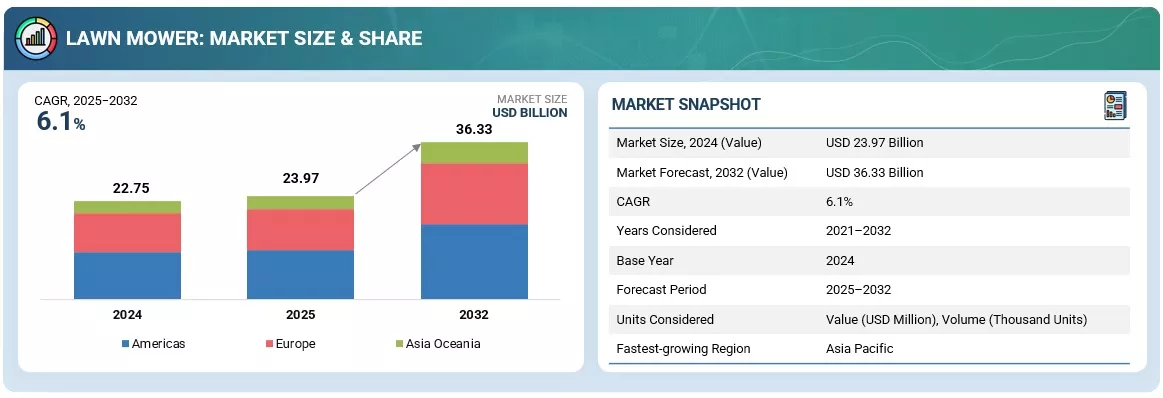
Source: Secondary Research, Interviews with Experts, MarketsandMarkets Analysis
The lawn mower market is projected to reach USD 36.33 billion by 2032 from USD 23.97 billion in 2025 at a CAGR of 6.1%. The lawn mower market is experiencing steady growth, primarily driven by the rising adoption of battery-powered and robotic models. This shift is supported by advancements in battery technology, quieter operations, and reduced operating costs. Additionally, urban green space development initiatives in regions such as China, India, and the European Union are further accelerating demand. However, the market continues to face challenges, including dependence on imported batteries and semiconductors, which create supply chain vulnerabilities. Furthermore, varying regional safety and noise regulations increase compliance costs and often delay product launches.
KEY TAKEAWAYS
-
BY TYPEWalk-behind mowers lead residential adoption due to affordability and compact design, while ride-on and zero-turn dominate commercial applications, meeting the needs of large-scale landscaping efficiently.
-
BY PROPULSIONGasoline-powered mowers remain dominant for their high power, long runtime, and reliability on large or challenging terrains, though electric mowers are gaining traction with improved battery performance.
-
BY END-USERResidential demand is rising for robotic and battery-powered mowers, enabled by 60–90 min runtimes and fast charging. Commercial users continue prioritizing ride-on and zero-turn mowers to maximize productivity and operational efficiency.
-
BY LAWN SIZESmall lawns favor walk-behind, manual, or robotic mowers; medium lawns prefer battery or corded options; large lawns rely on ride-on and zero-turn mowers for speed, power, and wide coverage.
-
BY REGIONThe Americas lead the lawn mower market, driven by high residential lawn ownership, strong disposable incomes, urbanization, expanding landscaping demand, and supportive regulations that accelerate the adoption of electric, robotic, and premium mowers.
-
COMPETITIVE LANDSCAPELeading companies such as Husqvarna, John Deere, Honda, and Toro are leveraging battery and robotic mower innovations through targeted R&D, strategic partnerships, and product diversification, while integrating smart home and fleet solutions to strengthen market position.
The lawn mower market is set to grow steadily over the next decade, driven by advances in propulsion systems, digital integration, and the global shift toward eco-friendly landscaping. Battery-powered and robotic mowers are accelerating adoption as consumers and businesses prioritize low emissions, efficiency, and compliance with regulations. Increasing use of smart features such as GPS, sensors, and IoT connectivity is transforming mowers into intelligent equipment that enhances precision and reduces operational costs. With rising demand from both residential and commercial sectors, manufacturers are focusing on lightweight designs, high-performance motors, and automation. This positions lawn mowers as a critical tool for sustainable and cost-effective landscaping, shaping future adoption across households, municipalities, and service providers.
TRENDS & DISRUPTIONS IMPACTING CUSTOMERS' CUSTOMERS
The lawn mower industry is undergoing a significant transformation, driven by technological innovation, regulatory pressures, and shifting customer preferences. While today’s market continues to rely heavily on conventional gasoline-powered equipment, the next four to five years are expected to see a dramatic revenue shift toward electric, battery-powered, robotic, and smart connected solutions. This transition from battery-powered mowers to robotic/intelligent lawn mowers is being shaped by new use cases, evolving ecosystems, and the growing influence of sustainability mandates.
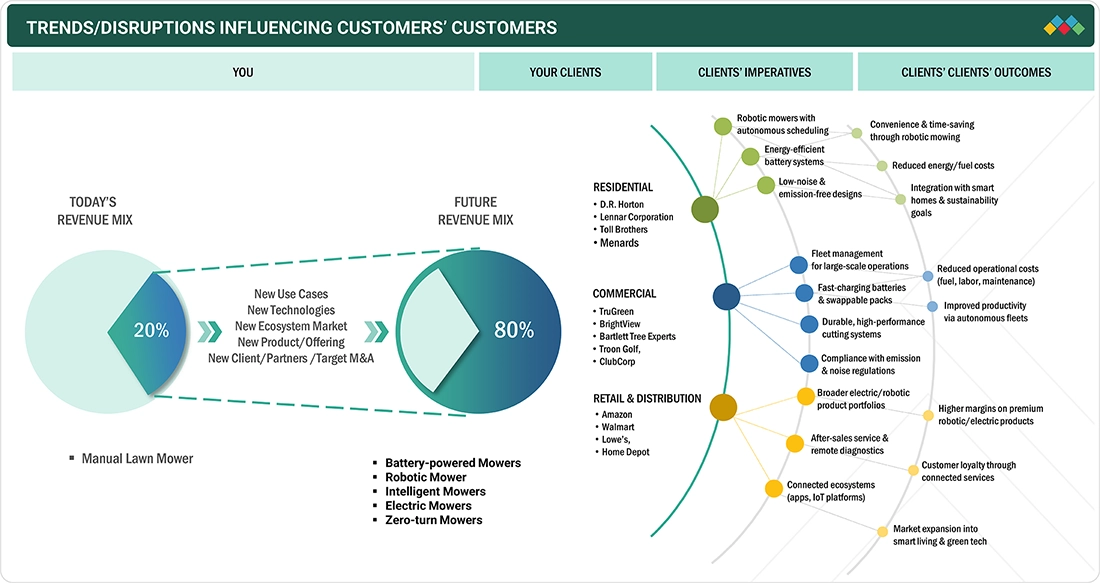
Source: Secondary Research, Interviews with Experts, MarketsandMarkets Analysis
MARKET DYNAMICS
Level
-
Surge in demand from residential and commercial sectors

-
Elevated demand for eco-friendly mowers
Level
-
High cost of lawn mowers
-
Rapid adoption of synthetic grass
Level
-
Introduction of subscription-driven services
Level
-
Seasonal dependency of lawn mowers
-
Technological gap between large OEMs and smaller players
Source: Secondary Research, Interviews with Experts, MarketsandMarkets Analysis
Driver: Elevated demand for eco-friendly mowers
Market growth is fueled by eco-friendly battery mowers, powered by high-capacity lithium-ion packs (up to 60V/10Ah) that rival small gasoline engines. Brushless DC motors boost efficiency and lower maintenance, improving lifecycle costs while meeting stricter urban noise and emissions standards.
Restraint: Rapid adoption of synthetic grass
Rising synthetic turf adoption curbs mower demand, supported by rebates in water-stressed regions (e.g., California, Australia) and India’s Smart Cities Mission. By mid-2025, Southern California alone replaced more than 200 million sq. ft. of lawns. Suppliers like Shaw Sports Turf and SYNLawn report strong municipal and commercial uptake, creating a structural challenge for conventional mower sales.
Opportunity: Introduction of subscription-driven services
Subscription-driven services shift the market from ownership to subscription, cutting upfront costs for homes, municipalities, and businesses. Offered by Husqvarna, Robin Autopilot, and Kobi, these autonomous, low-noise units include installation, maintenance, and smart integration. RaaS supports smart city goals, drives recurring revenue, and expands access to sustainable lawn care.
Challenge: Seasonal dependency of lawn mowers
Lawn mower demand peaks in spring/summer and drops in fall/winter, especially in North America and Europe. OEMs face profit swings (e.g., Husqvarna’s 21% decline in April 2025), while commercial buyers align purchases with growing seasons. Initiatives like India’s Smart Cities show uneven procurement, and weather-dependent grass growth limits steady market expansion despite battery and robotic mower advantages.
lawn mower market: COMMERCIAL USE CASES ACROSS INDUSTRIES
| COMPANY | USE CASE DESCRIPTION | BENEFITS |
|---|---|---|
 |
Deploying autonomous robotic lawn mowers equipped with GPS navigation, AI-based obstacle detection, and IoT connectivity for residential and commercial landscaping | Enhances mowing precision, reduces labor dependency, supports eco-friendly operations through battery technology, and strengthens Husqvarna’s positioning as a leader in smart outdoor solutions |
 |
Developing IoT-enabled sensors and control modules for robotic lawn mowers, enabling predictive maintenance and remote fleet monitoring | Improves mower efficiency and reliability, strengthens OEM integration, and drives innovation in connected landscaping equipment |
 |
Deploying fleets of electric and robotic mowers across corporate campuses, parks, and sports fields to optimize large-scale grounds maintenance | Reduces labor costs, lowers carbon footprint, improves operational uptime, and enhances service quality for clients |
 |
Providing replacement batteries, smart mower accessories, and servicing support for robotic and electric lawn mowers across its retail and service network | Creates strong aftermarket revenue streams, increases customer loyalty, and extends mower lifecycle through reliable maintenance support |
Logos and trademarks shown above are the property of their respective owners. Their use here is for informational and illustrative purposes only.
MARKET ECOSYSTEM
The lawn mower ecosystem includes OEMs such as Husqvarna, John Deere, Honda, and Toro that design and assemble products across walk-behind, ride-on, and robotic categories. They are supported by key component and sub-assembly suppliers, including Briggs & Stratton (engines), CATL and LG Chem (batteries), and Bosch (sensors and electronics), with inputs from raw material suppliers providing steel, aluminum, plastics, and lithium for battery packs. The value chain is completed by distributors and retailers such as Home Depot, Lowe’s, Amazon, and regional dealerships that ensure last-mile access to residential, commercial, and municipal end users.
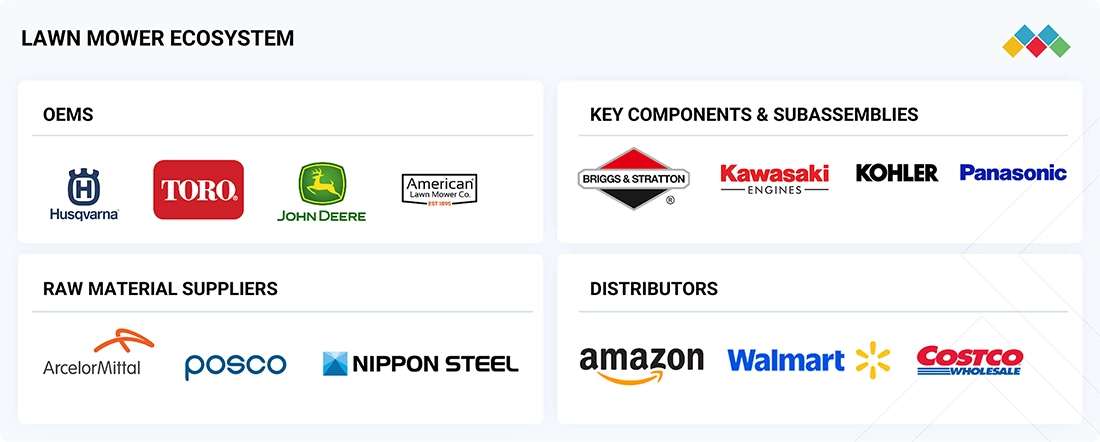
Logos and trademarks shown above are the property of their respective owners. Their use here is for informational and illustrative purposes only.
MARKET SEGMENTS
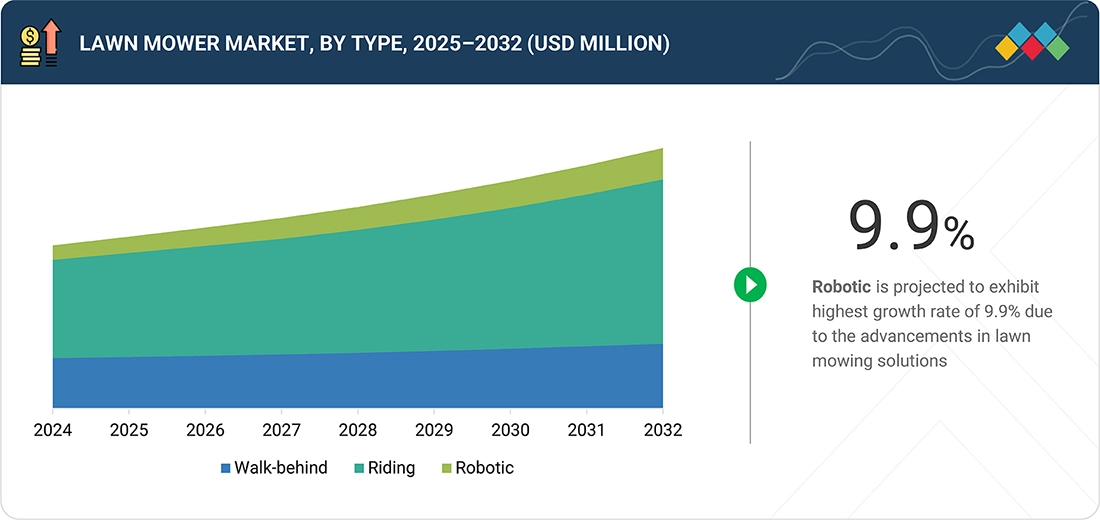
Source: Secondary Research, Interviews with Experts, MarketsandMarkets Analysis
Lawn Mower Market, by Type
Walk-behind mowers dominate by volume, supported by affordability (USD 300–600), strong aftermarket support, and suitability for small to mid-sized lawns in suburban and urban areas. Their maneuverability, compact storage, and lower operating costs make them the most practical and scalable choice for price-sensitive homeowners.
Lawn Mower Market, by Propulsion
Gasoline mowers are estimated to account for the largest share due to robust performance, operational independence from charging infrastructure, and applicability across residential and commercial use. With competitive pricing (USD 250–2,000) and mechanically simpler designs enabling high uptime, they remain the most resilient option for intensive mowing needs despite the rise of electric alternatives.
Lawn Mower Market, by End User
Residential users lead the market, driven by widespread ownership of small to medium lawns. Their demand is fueled by affordability (USD 150–600), ease of operation, compact design, and long-term reliability reinforced by spare part availability and low maintenance requirements, making them the most efficient segment for mass adoption.
Lawn Mower Market, by Lawn Size
Small lawns are the fastest-growing segment, aligned with the rising share of compact properties in urban and suburban regions. Lightweight, energy-efficient mowers with optimized engines or motors for smaller areas offer cost-effectiveness, practicality, and reduced wear, cementing this category as the most dynamic growth driver.
REGION
Americas to be largest region in global lawn mower market during forecast period
The Americas remain the largest market for lawn mowers due to a combination of high residential lawn density, strong consumer purchasing power, and widespread adoption of advanced mower technologies. The region exhibits trends toward battery-powered and eco-friendly mowers, integration of smart features for precision cutting, and rising interest in automated or semi-automated solutions for commercial landscaping. Well-established distribution channels and aftermarket support further reinforce adoption rates. Technically, North American consumers prefer mowers with optimized engine-to-deck ratios, durable cutting systems, and modular components for easy maintenance, enhancing efficiency and longevity. Leading companies in the region include John Deere, Toro, and Husqvarna, which dominate through a combination of innovation, brand reputation, and extensive service networks.
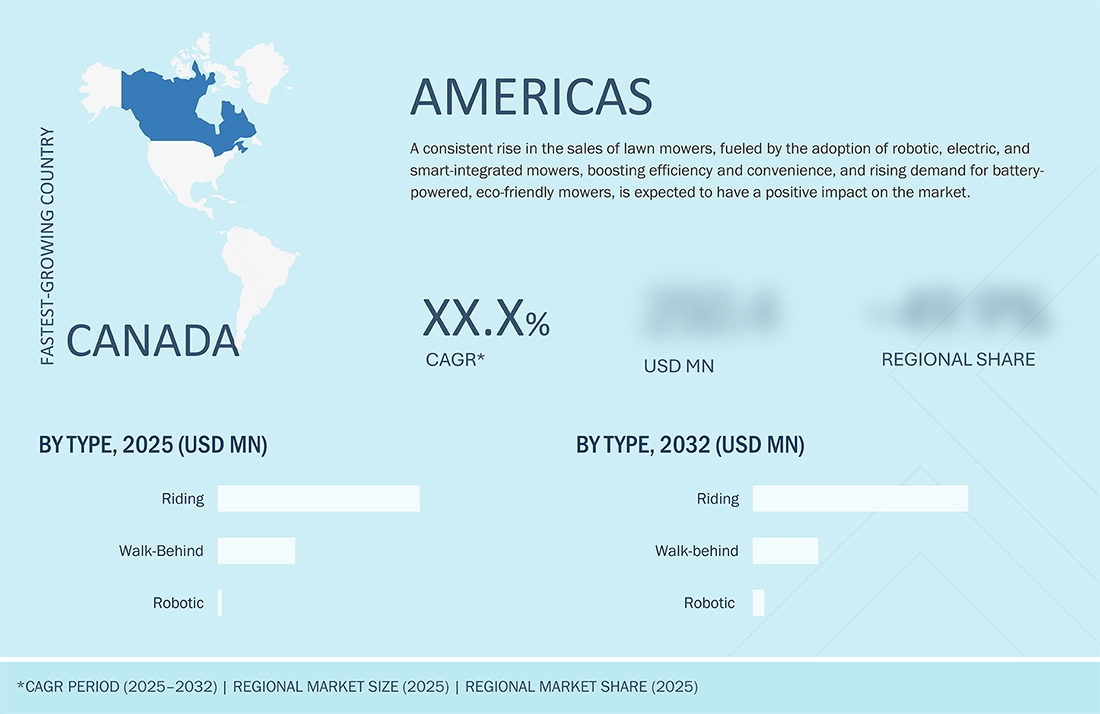
lawn mower market: COMPANY EVALUATION MATRIX
In the lawn mower market matrix, Deere & Company (Star) leads with a strong market presence and a wide product portfolio, driving large-scale adoption across industries like automotive and electronics. EGO Power+ (Emerging Leader) is gaining traction with sustainable lawn mower solutions such as electric lawn mowers, catering to various user needs through distinct product series. While Deere & Company dominates with scale, EGO Power+ shows strong growth potential to advance toward the leaders’ quadrant.
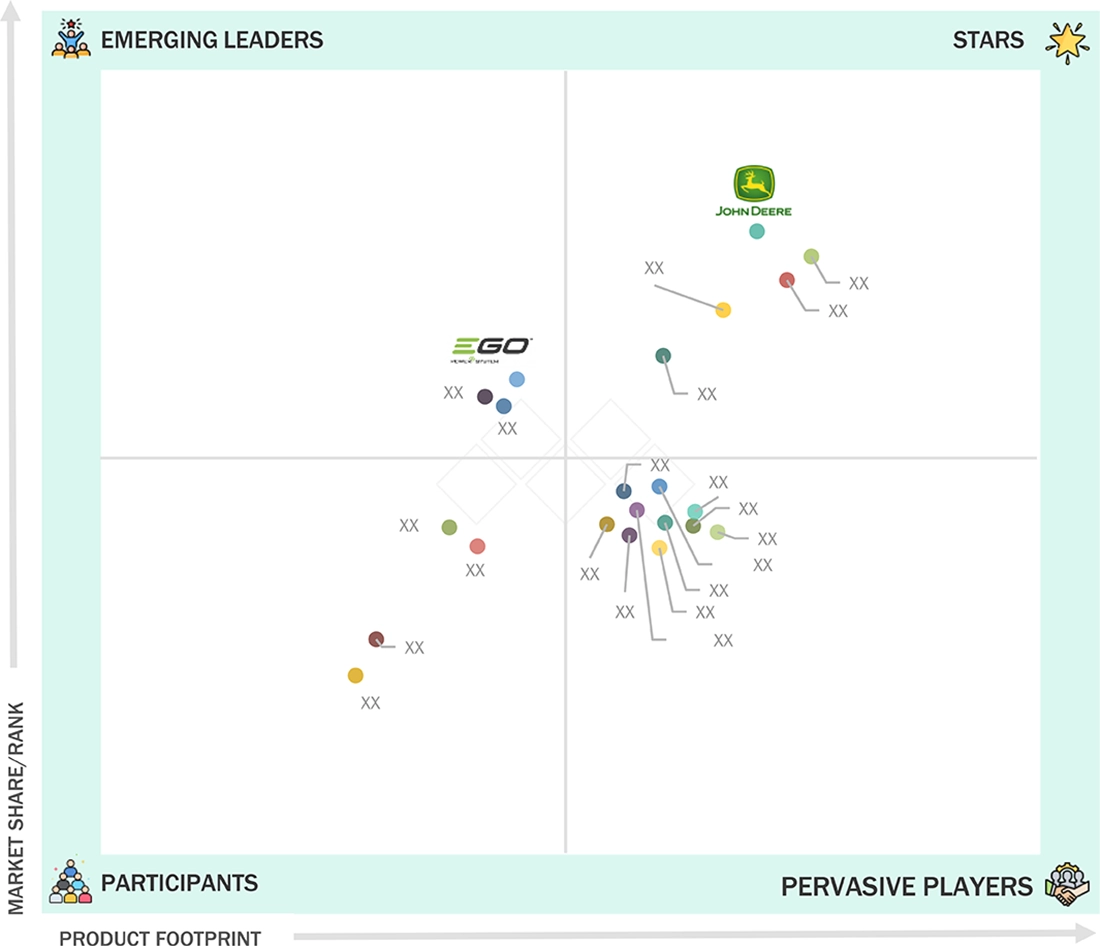
Source: Secondary Research, Interviews with Experts, MarketsandMarkets Analysis
KEY MARKET PLAYERS
MARKET SCOPE
| REPORT METRIC | DETAILS |
|---|---|
| Market Size, 2025 (Value) | 23.97 BN |
| Market Forecast, 2032 (Value) | 36.33 BN |
| Growth Rate | CAGR of 6.1% from 2025 to 2032 |
| Years Considered | 2021–2032 |
| Base Year | 2024 |
| Forecast Period | 2025–2032 |
| Units Considered | Value (USD Million), Volume (Thousand Units) |
| Report Coverage | Revenue forecast, company ranking, competitive landscape, growth factors, and trends |
| Segments Covered |
|
| Regional Scope | Asia Oceania, Europe, and the Americas |
WHAT IS IN IT FOR YOU: lawn mower market REPORT CONTENT GUIDE
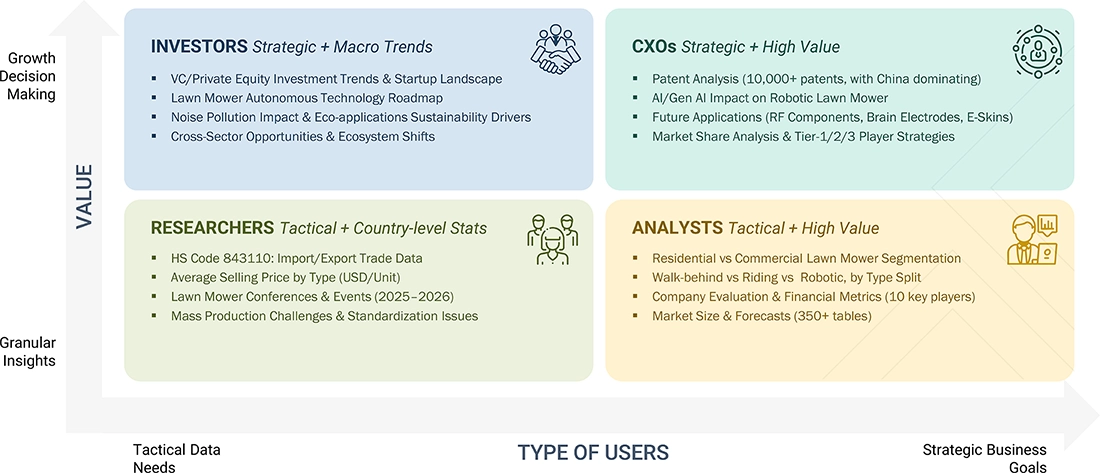
DELIVERED CUSTOMIZATIONS
We have successfully delivered the following deep-dive customizations:
| CLIENT REQUEST | CUSTOMIZATION DELIVERED | VALUE ADDS |
|---|---|---|
| US-based Lawn Mower Manufacturer |
|
|
| Lawn Mower Component Manufacturer (Engines, Batteries, Cutting Systems) |
|
|
| Global & Regional Lawn Mower Supplier Landscape |
|
|
| Automotive OEMs & Fleet Operators (as Lawn Mower Customers) |
|
|
RECENT DEVELOPMENTS
- 7/1/2025 12:00:00 AM : Honda launched new battery-powered lawn mowers for the summer of 2025. The company enhanced the product and launched the lawn mowers, which included HRN-BV, HRX-BV, HRX-BE, and HRC-BE lawn mowers. These lawn mowers were equipped with advanced lithium-ion batteries (30–45 mins run time), Smart Drive self-propel, and Honda’s twin-blade cutting system. These are built for both residential and commercial use.
- 5/1/2025 12:00:00 AM : Husqvarna launched a wireless robotic mower lineup with new Automower NERA models designed for small-to-medium-sized gardens. The Automower 305E NERA and 405XE NERA offer flexible mowing patterns, advanced boundary options, including GPS-based EPOS technology, and features such as EdgeCut for precise edging. The 405XE has cellular connectivity and radar for obstacle detection. Additionally, the Automower 435X AWD NERA supports wire-free mowing on rugged terrain with enhanced slope capability and smart connectivity.
- 3/1/2025 12:00:00 AM : Kubota launched new lawn mowers in the SZ Series, named SZ22NC-48-2, a stand-on mower with a 22-horsepower Kawasaki FX engine and HydroGear integrated transmission for smooth and precise control. These mowers are designed with a compact frame for easy maneuverability in tight spaces, increased operator visibility, and the option to stand or walk behind the mower.
- 2/1/2025 12:00:00 AM : The Toro Company recently entered into a strategic partnership with Yamabiko Europe, a subsidiary of Yamabiko Corporation, aimed at expanding robotic solutions and technologies for golf courses and sports field markets. The collaboration focused on developing and launching innovative robotic products, including a robotic lawnmower and a golf ball picker, with sales planned to start in Spring 2025.
Table of Contents

Methodology
The study involved four major activities in estimating the current size of the lawn mower market. Exhaustive secondary research was conducted to collect information on the market, the peer market, and the parent market. The next step was to validate these findings and assumptions and size them with industry experts across value chains through primary research. The bottom-up and top-down approaches were employed to estimate the complete market size. Thereafter, market breakdown and data triangulation processes were used to estimate the market size of segments and subsegments.
Secondary Research
The lawn mower market is directly dependent on mower production. Lawn mower sales/registration volume was derived through secondary sources such as industry organizations, corporate filings (such as annual reports, investor presentations, and financial statements), trade, paid repository, and relevant associations such as COMAGARDEN, Agricultural Engineers Association (AEA), European Garden Machinery Federation (EGMF), and OPEI. Historical sales/registrations data was collected and analyzed, and the industry trend was considered to arrive at the forecast, which was further validated by primary research.
Primary Research
In the primary research process, various primary sources from both the supply and demand sides were interviewed to obtain qualitative and quantitative information on the market. The primary sources from the supply side included various industry experts, such as CXOs, vice presidents, directors from business development, marketing, and product development/innovation teams, and related key executives from various key companies. Various system integrators, industry associations, independent consultants/industry veterans, and key opinion leaders were also interviewed.
Primary interviews were conducted to gather insights such as lawn mower sales/registrations and market forecasts, future technology trends, and upcoming technologies in the industry. Using the information gathered from secondary research and model mapping, data triangulation of all these points was carried out. Stakeholders from the demand and supply sides were interviewed to understand their views on the aforementioned points.
Primary interviews were conducted with market experts from both the demand (lawn mower manufacturers) and supply (component manufacturers) sides across four major regions, North America, Europe, Asia Oceania, and the Rest of the World. Approximately 45% and 55% of primary interviews were conducted with the end user and the OEM and tier-1 supplier, respectively. Primary data was collected through questionnaires, emails, and telephonic interviews. In the canvassing of primaries, various departments within organizations, such as sales, marketing, operations, R&D, and aftermarket, were covered to provide a holistic viewpoint in the report.
After interacting with industry experts, brief sessions were conducted with highly experienced independent consultants to reinforce the findings from the primaries. This, along with the in-house subject matter expert opinions, led to the findings as described in the remainder of this report.
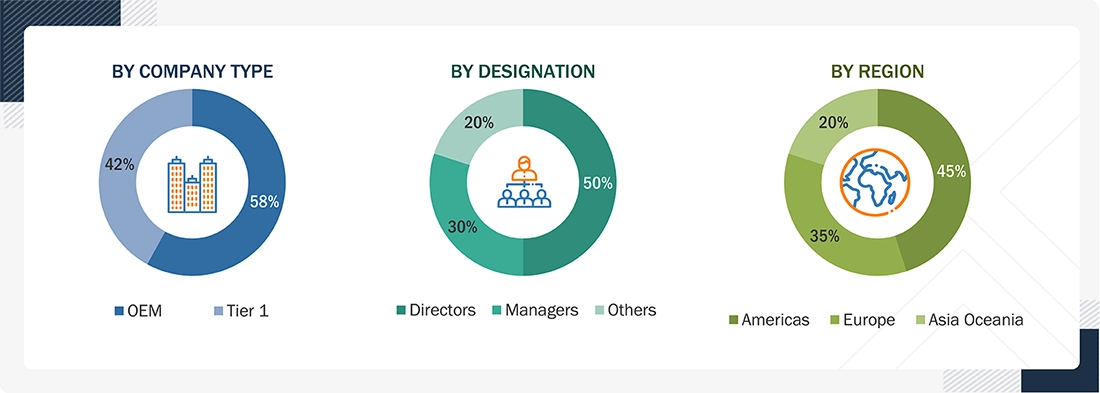
Note 1: Others include sales managers, marketing managers, and product managers.
Note 2: Tier 1 companies’ revenues are more than USD 10 billion; tier 2 companies’ revenues range between USD 1 and 10 billion; and tier 3 companies’ revenues range between USD 500 million and USD 1 billion.
Source: Industry Experts
To know about the assumptions considered for the study, download the pdf brochure
Market Size Estimation
A detailed market estimation approach was followed to estimate and validate the value of the lawn mower market and other dependent submarkets, as mentioned below:
- Key players in the lawn mower market were identified through secondary research, and their global market shares were determined through primary and secondary research.
- The research methodology included a study of annual and quarterly financial reports and regulatory filings of major market players (public), as well as interviews with industry experts for detailed market insights.
- All industry-level penetration rates, percentage shares, splits, and breakdowns for the lawn mower market were determined using secondary sources and verified through primary sources.
- All key macro indicators affecting the revenue growth of the market segments and subsegments were accounted for, viewed in extensive detail, verified through primary research, and analyzed to get the validated and verified quantitative and qualitative data.
- The gathered market data was consolidated and added with detailed inputs, analyzed, and presented in this report.
- Qualitative aspects such as market drivers, restraints, opportunities, and challenges were taken into consideration while calculating and forecasting the market size.
Lawn Mower Market : Top-Down and Bottom-Up Approach
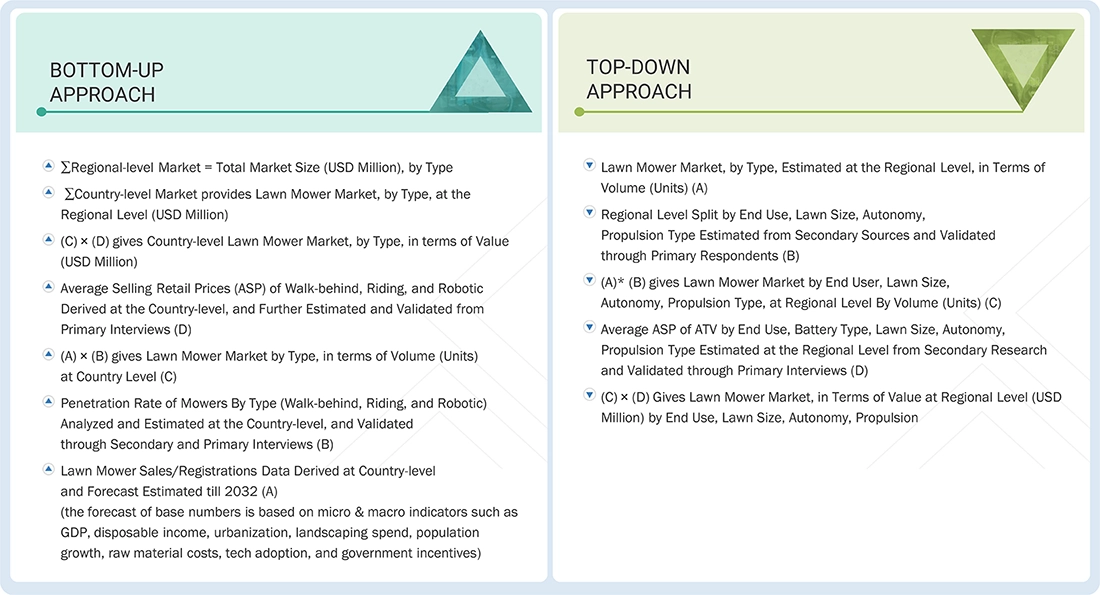
Data Triangulation
After arriving at the overall market size using the market size estimation processes as explained above, the market was split into several segments and subsegments. To complete the overall market engineering process and arrive at the exact statistics of each market segment and subsegment, data triangulation and market breakdown procedures were employed, wherever applicable. The data was triangulated by studying various factors and trends from both the demand and supply sides.
Stakeholders
- Global lawn mower manufacturers & component suppliers
- Battery technology providers
- Electrical and electronic component suppliers
- Equipment rental companies
- Government & municipalities
- Government & regulatory bodies
- Landscaping & gardening service companies
- Lawn mower component suppliers
- Legal and regulatory authorities
- Market research firms and consultancies
- Outdoor Power Equipment Institute (OPEI)
- Regulatory & standards bodies
- Research & development (R&D) centers
- Retailers & channel partners
- Robotics & AI firms
- Software providers & simulation specialists
- Sports facilities & golf courses - subscription/remote monitoring service providers
- Third-party maintenance/ professional landscaping providers
Report Objectives
- To define, describe, and forecast the lawn mower market with respect to individual growth trends and prospects, and determine the contribution of each segment to the total market
-
To forecast the lawn mower market size by volume (units) and value (USD million) based on
- By type (riding, walk-behind, robotic)
- By lawn size (small, medium, and large)
- By end user (residential and commercial)
- By propulsion type (electric and ICE)
- By autonomy (autonomous and non-autonomous)
- By robotic lawn mower market, by hardware (sensors [ultrasonic, lift, tilt], motors (blade, wheel), microcontrollers, and batteries)
- By region [Asia Pacific (China, India, Japan, South Korea, Australia, and New Zealand), Europe (Germany, France, UK, Italy, Sweden, Russia, Spain, and Rest of Europe), and the Americas (US, Canada, Mexico, and Brazil)]
- To analyze the market qualitatively by Distribution Channel (online and retail)
- To provide detailed information regarding the major factors influencing the growth of the market (drivers, restraints, opportunities, and challenges)
- To strategically analyze the market with macroeconomic outlook, trends/disruptions impacting buyers, case studies, patent analysis, supply chain analysis, market ecosystem, regulatory analysis, impact of AI/Gen AI on lawn mower market, brand comparison, company valuation, investment & funding scenario, and technology trend, trade analysis, average selling price analysis
- To understand the competition in the lawn mower market and position the players as stars, emerging leaders, pervasive players, and participants according to their product portfolio and business strategies
- To analyze the market share of leading players in the lawn mower market and evaluate the competitive leadership mapping
- To strategically analyze the key player strategies/right to win, and company revenue
- To analyze the opportunities in the market for stakeholders and provide details of the competitive landscape for market leaders
- To provide an analysis of recent developments, alliances, joint ventures, mergers & acquisitions, product launches, and other activities carried out by key industry participants in the lawn mower market
Available Customizations
With the given market data, MarketsandMarkets offers customizations in accordance with the company’s specific needs.
Robotic lawn mower market, by type, at the country level
Lawn mower market, by end market, at the country level
Company information
- Profiling of additional market players (up to three)
Need a Tailored Report?
Customize this report to your needs
Get 10% FREE Customization
Customize This ReportPersonalize This Research
- Triangulate with your Own Data
- Get Data as per your Format and Definition
- Gain a Deeper Dive on a Specific Application, Geography, Customer or Competitor
- Any level of Personalization
Let Us Help You
- What are the Known and Unknown Adjacencies Impacting the Lawn Mower Market
- What will your New Revenue Sources be?
- Who will be your Top Customer; what will make them switch?
- Defend your Market Share or Win Competitors
- Get a Scorecard for Target Partners
Custom Market Research Services
We Will Customise The Research For You, In Case The Report Listed Above Does Not Meet With Your Requirements
Get 10% Free CustomisationGrowth opportunities and latent adjacency in Lawn Mower Market














Jathin
Dec, 2022
Who is the largest manufacturer of lawn mowers Market Industry? Can you please share the detailed forecast for Lawn Mowers Industry in Europe? .
Rubika
Aug, 2022
Who are the top vendors in the Lawn Mower Market? What is the competitive scenario among them from the forecast year 2022 to 2027? .
Alex
Jul, 2022
What are Lawn Mower Market Newer business models like sustainable and profitable revenue streams in the future?.